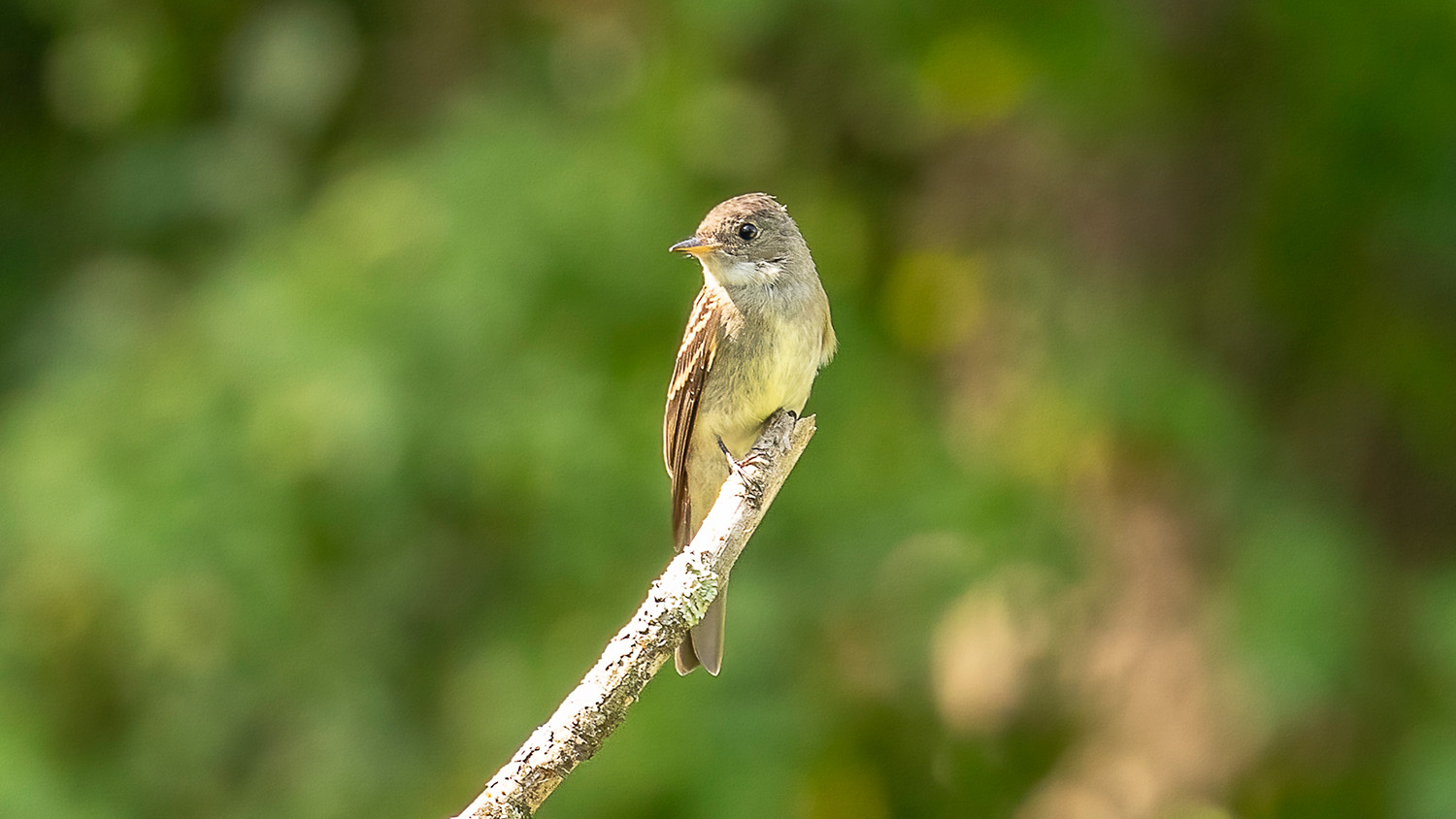Bird Diversity Increased in Severely Burned Forests of Southern Appalachian Mountains

A new study found bird diversity increased in North Carolina mountain forest areas severely burned by wildfire in 2016, reinforcing that while wildfire can pose risks to safety and property, it can be beneficial to wildlife. The study results could help forest managers better predict bird responses to wildfire, and manage forests to benefit birds.
“It’s important for us to understand the relationships between animals and wildfire dynamics as the climate changes because predictions show more of these high-severity wildfires across the landscape in the future,” said study co-author Chris Moorman, professor of forestry and environmental resources at North Carolina State University.
Wildfires burned more than 235 square miles of forest in the southern Appalachians in the fall of 2016, following a period of dry conditions and acts of arson. In the study published in the journal Forest Ecology and Management, researchers tracked different levels of burn severity in three forest regions of the Nantahala National Forest in western North Carolina.
Researchers counted the abundance and diversity of birds during the breeding season in those forest regions across five years. They used that data to compare bird communities in patches burned to different degrees of severity.
“Birds and other animals are well known to respond to forest vegetation structure, which is the distribution of plants vertically in a forest,” Moorman said. “When wildfire changes the vegetation structure, it has an impact on the animals that live there.”
In severely burned areas, researchers documented loss of most of the canopy trees, followed by the regrowth of dense shrubs and the re-sprouting of trees. In areas impacted by high severity fire, 44% of the trees died in the first year, and 71% had died by the fifth year. That compared to 7% tree mortality in unburned areas.
“After the high-severity wildfires, everything was brown and black and appeared dead,” Moorman said. “But changes happen fast in the southeastern U.S., and vegetation grew back rapidly.”
When they compared the numbers of birds in areas of different fire severity, they found an increase over time in the number of birds, as well as greater bird diversity, in forest areas where wildfire severity was high. By the fifth year, the total abundance of birds and the species richness, or number of different species present, in areas of high-severity burns were twice as high as that in unburned areas.
While it seems counterintuitive that high-severity patches supported more bird species, researchers said that’s because few species avoided the high-severity patches, but several species were more abundant or occurred only in those patches. More specifically, the indigo bunting, chestnut-sided warbler and eastern towhee – all species that breed in shrubs in areas with few or no canopy trees – occurred almost exclusively in the high-severity burn patches.
“When we do low-intensity prescribed fire under an intact tree canopy, we don’t benefit these bird species that prefer to nest in shrubland,” Moorman said. “In fact, low-severity burns – whether by wildfire or prescribed fire – have little effect on breeding bird species or communities at all.”
One species, the ovenbird, showed a trend of lower abundance in severely burned areas. However, the abundance of seven species was greatest in higher severity areas, and 11 species didn’t differ among the areas.
“I think a lot of the forest birds are not as particular as the literature might have previously suggested, as long as there is some vertical structure – like some live trees or standing snags – and cover,” said the study’s lead author Cathryn Greenberg, a research ecologist with the U.S. Forest Service. “Other studies show that even mature forest birds bring their young into recently disturbed areas, where insects and fruits are abundant, to learn how to forage under thick shrub cover for protection.”
Moorman said it’s likely that high-severity patches were small enough, or incomplete enough on the landscape, that it didn’t impact birds that live in the canopy or otherwise rely on the canopy trees.
“Most of the western NC landscape contains continuously closed canopy forest, so you get this new structural condition associated with canopy removal from high-severity burns that benefit shrubland bird species, but you still have the canopy present nearby for other birds,” Moorman said.
Researchers said the findings have implications for managing forests to promote bird diversity.
“It’s not a practical or logical approach to manage for high-severity wildfires across the landscape because of the obvious risks to safety and the loss of timber revenue,” Moorman said. “However, there are types of timber harvest that could create similar structural conditions to that created by high-severity wildfires.”
The study “Breeding bird abundance and diversity greatest in high-severity wildfire patches in central hardwood forests,” was published in Forest Ecology and Management. Co-authors included Katherine J. Elliott, Katherine Martin, Mark Hopey, and Peter Caldwell. The study was funded by the USDA Forest Service Coweeta Hydrologic Laboratory Southern Research Station; Nantahala Ranger District Southern Region 8; the Water Resources Program Washington Office; the National Science Foundation Long-term Ecological Research program (award #DEB-0823293); the USDA Institute of Food and Agriculture, Agricultural and Food Research Initiative Competitive Program, Agro-Ecosystem Management (award #2017-67019-26544); the Nature Conservancy; and the U.S. Forest Service North Carolina Supervisor’s Office.
-oleniacz-
Note to editors: The abstract follows.
“Breeding bird abundance and diversity greatest in high-severity wildfire patches in eastern hardwood forests”
Authors: Cathryn Greenberg, Christopher E. Moorman, Katherine J. Elliott, Katherine Martin, Mark Hopey and Peter V. Caldwell.
Published online on Dec. 15 in Forest Ecology and Management.
DOI: 10.1016/j.foreco.2022.120715
Abstract: In 2016, mixed-severity wildfires in the southern Appalachians created a gradient of forest structures not typical following prescribed burns, providing a unique opportunity to study temporally dynamic conditions and breeding bird response. We measured forest structure and breeding bird communities across a fire-severity gradient in 3 burned and 3 unburned watersheds for 5 years (Y1-Y5). We categorized plots as unburned (NB), low- (L), moderate- (M), or high-severity (H) using a composite fire-severity index. Tree mortality increased with fire-severity category (FSC) and over time; by Y5, 7% of trees in NB, 11% in L, 38% in M, and 71% in H had died. Shrub recovery was rapid and most pronounced in H, exceeding other FSCs (70% vs 21%-44%) by Y5. Total bird abundance, species richness, and diversity increased over time in H (by Y3) and M (by Y4); by Y5, these metrics were highest in H and twice as high in H as in NB. Low-severity wildfires had no detectable effects on birds. Abundance of 7 species was greatest in higher-severity FSCs; 11 species did not differ among FSC, although ovenbirds (Seiurus aurocapilla) indicated a trend of lower abundance in H. No species was limited to NB, L, or M, whereas disturbance-dependent indigo bunting (Passerina cyanea), chestnut-sided warbler (Setophaga pensylvanica), and eastern towhee (Pipilo erythrophthalmus) were primarily associated with H. Increased richness and diversity were associated with heavy tree mortality and subsequent shrub recovery in H, accompanied by an influx of disturbance-dependent species and positive or neutral responses by most other species. Results highlight the interrelated roles of fire severity and time in driving forest structure and breeding bird response. Breeding birds responded to high-severity burns similarly to silvicultural treatments with heavy canopy reduction documented in other studies, offering possible alternatives when managing for breeding bird diversity in hardwood forests.


